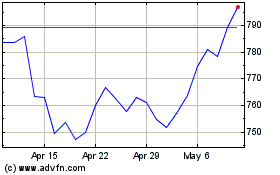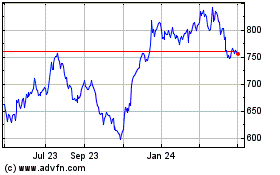If inflation returns, here are six strategies to protect a
portfolio
By Michael A. Pollock
With the global economy so sluggish, can bond investors rest
easy about inflation? Not necessarily. Excluding energy prices,
inflation might not be as tame as many think it is. Moreover, the
Federal Reserve, which stands guard over inflation, has signaled an
unusual willingness to tolerate inflation at a faster pace.
That is just what could result if the Fed raises interest rates
only gradually while the job market continues to heat up.
The Fed monitors several indexes of inflation, which vary
according to what prices are included. The most widely watched by
investors, the core consumer-price index, or CPI, rose 2.2% for the
12 months through March. This index excludes food and energy
prices. The key index watched by the Fed, however, is the core
price index for personal-consumption expenditures, or PCE, which
also excludes food and energy. It rose by 1.6% for the 12 months
through March.
Few expect that number to surge, in part because of currently
depressed energy markets. The Fed itself seems to discount the
possibility, as it has signaled it plans to raise rates only
gradually. Bond professionals say part of the Fed's hesitation to
raise rates also stems from the fact that it doesn't want to cause
more of the market volatility seen after it raised rates in
December for the first time in nine years.
If, however, the job market continues to heat up, other prices
keep rising, and the Fed does tolerate more inflation than in the
past, all of that could spell trouble for bondholders.
The apparent policy shift is "a big deal," says Rick Rieder,
chief investment officer of global fixed income at money manager
BlackRock Inc. A further increase in inflation, he says, could at
least temporarily cause yields to rise as bond investors turn
elsewhere for higher yields to stay ahead of inflation.
Bond yields move the opposite way as bond prices, so a rise,
reflecting an increase in inflation expectations, would cause many
bonds to lose value. That could be a concern for retirees and for
people using conservative asset mixes in company-sponsored 401(k)
plans, which often provide few fixed-income options.
But there are things investors can do to cushion inflation's
impact. Those include owning more stocks, holding a diverse mix of
bonds and adding certain bonds whose principal value would increase
with inflation. Here are some strategies to consider, along with
their potential upsides and downsides:
1. Look at what you have
Whether people need inflation insurance depends on what they
own. A well-diversified portfolio might already be relatively well
protected.
Bond professionals believe the Fed wants the PCE price index to
rise to above 2% from its current 1.6%. That would pose the most
concern to savers in low-yield bank or money-market accounts, whose
yields currently average 0.11%, Bankrate.com says. If that rate
didn't change and inflation averaged 2% a year, the purchasing
power of a $100,000 account would shrink to about $83,000 after 10
years.
Bonds currently don't offer great returns either, notes Crit
Thomas, senior investment strategist at Cincinnati-based Touchstone
Investments. But investors in well-diversified
intermediate-maturity bond funds can expect to get yields of around
2% to 3%, he says, which, for now at least, should mostly offset
inflation.
He cites Touchstone Flexible Income fund (FFSAX) as a tool for
earning stable income. According to Morningstar, the
intermediate-term bond fund recently had about 37% of its portfolio
in corporate bonds. The fund generates a yield of about 2.7% and
ranks in the top 8% of its category for the past five years.
For a passive approach, Morningstar gives a favorable review to
iShares Core Total USD Bond Market ETF (IUSB), which generates
about 2.4% in yield. Unlike the Touchstone fund or its active
peers, the ETF's portfolio doesn't change based on a manager's
identification of opportunities.
2. Own more stocks, fewer bonds
Some advisers say bonds no longer are a good tool for preserving
capital. They not only can lose value if rates rise, but yields of
high-quality bonds scarcely compensate investors for inflation.
Currently, 10-year Treasurys, which are highly sensitive to rate
risk, yield only 1.779%.
Chris Carosa, an adviser in the Rochester, N.Y., area, says
because risks are so high relative to returns, people shouldn't
keep any money in longer-term bonds that they might need within
five years.
For people with longer horizons, owning more stocks is one
solution, says Tim Courtney, chief investment officer at Exencial
Wealth Advisors in Oklahoma City. Rather than the traditional 60%
holding, Mr. Courtney says investors might consider keeping 70% of
a portfolio in stocks. Stocks would fare well if inflation averaged
around 2% or a little more, he says, though not as well if
inflation rose significantly.
The widely held reasoning: As inflation rises more sharply, that
tends to make it difficult for companies to raise prices rapidly
enough to keep up with rising costs they incur. This eats into
profits.
3. Invest in other corners of the world
Global markets move in closer sync than ever, but some foreign
economies aren't tracking the U.S. That's a reason to own foreign
bonds, says BlackRock's Mr. Rieder, who helps manage BlackRock
Global Strategic Bond (MDWIX). Economies in some countries are weak
enough, he says, that their central banks might follow policies
that will push down interest rates, offering bondholders some
opportunities for capital appreciation. He cites Australia, Italy
and South Korea as offering such possibilities. Bonds of Mexico and
Russia, meanwhile, could appreciate in the event of a commodities
recovery, he says.
Many foreign stocks, meanwhile, have higher yields than similar
investments in U.S. stocks, says Exencial's Mr. Courtney. He points
to foreign real-estate investment trusts, which yield as much as
4.5% a year, versus around 3.5% for U.S. REITs.
Mr. Courtney also expects the dollar to retreat at some point,
offering additional benefits for investors overseas. Holders of
foreign stocks could see their returns boosted if they sell and
convert profits back into dollars, and bond investors could enjoy
gains on both return of principal and interest payments.
A low-cost way of adding foreign REITs to a portfolio, Mr.
Courtney says, is Vanguard Global ex-U.S. Real Estate Index
(VGXRX), which also is available as an ETF ( VNQI). Each owns more
than 600 stocks in more than 40 countries.
4. Add some inflation-linked bonds
The U.S. Treasury sells bonds indexed to changes in the
consumer-price index, known as Treasury inflation-protected
securities, or TIPS. These offer one of the purest forms of
inflation protection.
TIPS have been poor performers recently as worries about the
economy and the collapse of oil prices crushed inflation
expectations. TIPS funds shed about 9% in 2013 and were down around
1.7% last year.
But at current levels, TIPS haven't adjusted to the idea that
inflation could top 2% if the Fed stands pat, some say. Daniel
Dektar, co-head of Amundi Smith Breeden's Investment Management
Group, says investors shouldn't expect "a thrilling return" from
TIPS. But if the Fed's preferred inflation measure does edge above
2%, TIPS are likely to outperform conventional Treasurys, and
possibly significantly, he adds.
Because TIPS are complex, individuals usually are better off
owning them in a fund or ETF. Morningstar Inc. picks include
Vanguard Inflation-Protected Securities (VIPSX) and Schwab U.S.
TIPS ETF (SCHP).
5. The benefits of corporate credit
Bonds of U.S. companies pay a yield premium, or spread, over
Treasurys to compensate for their lower credit standings. That
works out to yields of around 2.75% to more than 3% for bonds with
low investment-grade ratings such as single-A.
In contrast, high-yield (or junk) bonds may pay more than 7%.
But such bonds, which have much lower ratings, can lose a lot of
value when markets switch to "risk-off" mode. Early this year, the
principal value of some junk bonds fell as much as 10%.
"We aren't telling investors to stay away from high-yield," says
Warren Pierson, senior portfolio manager at Robert W. Baird &
Co., Milwaukee. Just understand that such bonds have about a 75%
correlation to moves in stocks, he says. To get diversification
from equities risk, investors need to own highly rated bonds such
as Treasurys.
Baird Short-Term Bond (BSBSX), which Mr. Pierson helps manage,
recently held about half its portfolio in corporate bonds with an
average credit quality of single-A. It yields 1.6% while having an
average maturity of less than two years, giving it only modest
exposure to a rate rise.
6. A dual role for bank-loan funds
Bank-loan funds, which feature floating rates, have attracted
investors looking for protection against rising interest rates.
Such funds can serve a dual purpose in an inflationary environment,
offering investors potential for both increasing yields and
appreciating principal.
Bank-loan funds own loans to companies with low credit ratings,
which thus pay higher yields -- rates that float about 5 percentage
points above a variable-rate benchmark such as Libor. So, as Libor
rises, bank-loan funds eventually pay higher yields -- although
under loan terms, there could be a significant lag before that
happens. Meanwhile, unlike what happens with bonds, the value of
the loans appreciates when yields rise, potentially giving
bank-loan fund investors an additional boost. Last year, bank-loan
funds as a group had a negative return of slightly more than 1%,
compared with about negative 4% for high-yield bond funds.
Among funds rated highly by Morningstar are Lord Abbett Floating
Rate (LFRAX) and RidgeWorth Seix Floating Rate High Income (SAMBX).
The A shares of each fund yield about 4.4%.
Mr. Pollock is a writer in Ridgewood, N.J. He can be reached at
reports@wsj.com.
(END) Dow Jones Newswires
May 09, 2016 02:48 ET (06:48 GMT)
Copyright (c) 2016 Dow Jones & Company, Inc.
BlackRock (NYSE:BLK)
Historical Stock Chart
From Aug 2024 to Sep 2024

BlackRock (NYSE:BLK)
Historical Stock Chart
From Sep 2023 to Sep 2024
